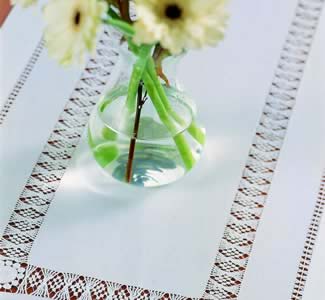- Home ›
- Irish crafts
Irish crafts
Any list of Irish crafts has a tendency to read like a tourist's shopping list, and the one below is no exception. The reason is simple: these crafted products have 'Irish' written all over them, sometimes quite literally, always figuratively. They are a tangible shorthand for 'Ireland'.
 Wicklow Weave Irish linen tablecloth from Fergusons, Banbridge, Co Down.
Wicklow Weave Irish linen tablecloth from Fergusons, Banbridge, Co Down.But while you may be happy to see these crafts as a list of ideas for creative Irish gifts or holiday souvenirs, you might well question how learning about them takes your family history research forward. It is, after all, hard to imagine that fine lead crystal or freshly laundered Irish linen featured in the daily life of those families huddling in mud and thatch cabins, as so many were in the 18th and 19th century!
However, most of these crafts developed from ancient skills our ancestors had passed down the generations and some, for example the craft of Tweed making, remain regional specialities only. Others were originally developed from imported skills and subsequently taken to a higher level due to the exceptional quality of local materials. Irish linen is an example of this phenomenon.
While only few of our ancestors would have enjoyed the ownership or use of many of these crafted products, many communities in Ireland benefitted by the employment these early industries provided. As such, Irish crafts have played a part – and sometimes a very significant part - in the lives of our ancestors and can help us to understand more about the world and society that informed their lives.
Featured Irish crafts
Irish textiles
- Aran Sweaters – the truth behind the fiction of clan stitches.
- Aran Sweaters – the symbolism of the stitches in Irish wool sweaters.
- Irish Linen – how Ireland earned the internationally recognised mark of quality.
- Irish Linen – the dirty work that transforms the flax plant into beautiful soft fabric.
- Irish Linen – the speciality of damask fabric.
- Mill work – unhealthy and dangerous.
- Irish lace - added to Ireland's National Inventory of Intangible Cultural Heritage in 2018.
Food and Drink
- Irish whiskey – the water of life.
- Irish cheese – the flavour of the land.
Irish tableware
- Irish crystal – the story behind the sparkling glass.
- Porcelain – from heavy clay soil to the table.
Watch, learn and buy
Today, these Irish crafts are mostly produced in high-tech 24/7 factories. Many of these have visitor centres where you can learn more about the craft involved and, of course, buy their beautiful Irish gifts and souvenirs.
There are also many individual craftspeople fine-tuning their traditional skills in small studios and workshops across Ireland where you can buy handmade crafts and observe their creation. Although scattered across Ireland, they are not difficult to find. Many now have websites or are listed in brochures produced by local tourist offices. Alternatively, contact the Design and Crafts Council Ireland.
